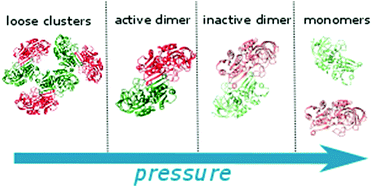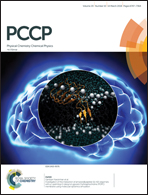The effects of osmolytes and crowding on the pressure-induced dissociation and inactivation of dimeric LADH†
Abstract
Investigating the correlation between structure and activity of oligomeric enzymes at high pressure is essential for understanding intermolecular interactions and reactivity of proteins in cellulo of organisms thriving at extreme environmental conditions as well as for biotechnological applications, such as high-pressure enzymology. In a combined experimental effort employing small-angle X-ray scattering, FT-IR and fluorescence spectroscopy as well as stopped-flow enzyme kinetics in concert with high-pressure techniques, we reveal the pressure-induced conformational changes of the dimeric enzyme horse liver alcohol dehydrogenase (LADH) on the quaternary, secondary and tertiary structural level. Moreover, the effects of cosolutes and crowding agents, mimicking intracellular conditions, have been addressed. Our results show that beyond an increase of enzymatic activity at low pressures, loss of enzyme activity occurs around 600–800 bar, i.e. in a pressure regime where small conformational changes take place in the coenzyme's binding pocket, only. Whereas higher-order oligomers dissociate at low pressures, subunit dissociation of dimeric LADH takes place, depending on the solution conditions, between 2000 and 4000 bar, only. Oligomerization and subunit dissociation are modulated by cosolvents such as urea or trimethylamine-N-oxide as well as by the crowding agent polyethylene glycol, based on their tendency to bind to the protein's interface or act via their excluded volume effect, respectively.



 Please wait while we load your content...
Please wait while we load your content...